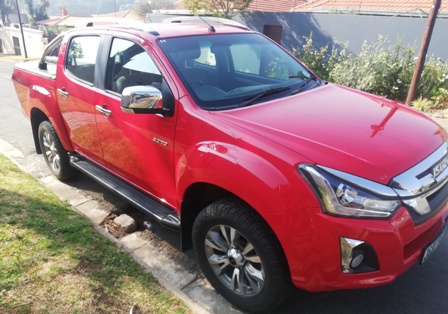When US General Motors exited SA in 2017, it left the brand Isuzu but having taken ownership from the Japanese, it renamed it KB range of bakkies, thus bringing it in line with the international market.
Ok- out with background history back to the comprehensive Isuzu D –Max range.
We tested the top-of-the-range D-Max 300 4×4 double cab LX as we made our trip to NW in Ganalaagte (my village) for the unveiling of tombstones and of course touring the platinum province. Yes, you might ask what is so platinum with potholes, water shortage abound and poor managed municipality. It sucks!
But thanks to the evergreen (though was testing Pull me Over Red) it was seamless for the D-Max.
This was largely due to its brash- and a new chromed radiator grille, along with chromed accents around the headlight clusters, plus restyled fog-lamps and LED daytime running lights on our particular model. There are similar, low-key changes when it comes to the interior with new soft-touch panels and an eight-inch full-colour touchscreen that replaces the 6.5-inch version in the previous model.
It has the striking 18-inch alloy wheels, as well as black side steps, roof rails and a stainless steel sportbar.
The most significant change, though, was the introduction of an all-new six-speed manual or automatic gearbox (replacing a five-speed version) and gearbox that feels more suited to the D-Max, with gear changes a little smoother.
Inside, Isuzu has been similarly clever when upgrading the ageing architecture’s look. The use of piano black surfaces and leather on the fascia cubby, for example, do much to create an impression of luxury. It’s also still very much in the game when it comes to comfort and convenience.
The seats proved comfortable on longer journeys (and off-road), and rear legroom is generous. A number of storage solutions are offered in addition to the door pockets – the storage box between the seats is generously sized, there is a secondary glove compartment (cooled) and another lidded box on top of the fascia (with a sticky opening mechanism on our test unit).
Reliable, safe and rugged bakkie- that’s what it offers and yes, the likes of its competitors Toyota Hilux and Ford Ranger, should be very worried. Very!
On the safety side, the LX Auto features 6 airbags, ABS with EBD and stability control (with trailer-sway control). In addition, ISOfix rear child-seat anchors are fitted, as are rear parking sensors and a reverse-view camera.
Solid off-road performance has always been one of the Isuzu’s strengths and this D-Max is no different. Isuzu claims a ground clearance of 220 mm, as opposed to its rivals.
It offers 3.0-litre turbodiesel engine. The power-plant still competes well, with a power output of 130 kW and torque rated at 380 Nm from 1 800 to 2 800 rpm.
A big change is that the engine is now mated with a new 6-speed automatic transmission, instead of the 5-speeder that did duty before. The change is welcome – the D-Max is now a quieter cruiser in its higher gears and the first gear is quite useful at slow speeds in the rough – but it can’t completely hide the inherent gruffness of the engine, nor its comparative lack of refinement.
The D-Max is a rough-sounding vehicle most of the time, and the power doesn’t come as freely as in some rival vehicles.
Not a heavy load- that’s until we loaded everything from pots, meal-mealie to sugar, drinks to mattresses to anything you might think of when hosting such a huge ceremony of tombstones, a lot is expected from you. And it didn’t just end there…
Still, the D-Max was game.
It offered a segment-competitive 3 500 kg towing capacity (braked), provided maximum vehicle mass does not exceed 2 500 kg. It has a 945 kg payload rating. In terms of fuel (diesel) efficiency, the D-Max is also competitive. Isuzu claims a combined cycle figure of 7.8 L/100km and we achieved a figure of closer to 9.6 L/100km.
There might be an unfamiliar badge on the Isuzu bakkie, but what the KB used to stand for has thankfully been carried over to the D-Max, of which it’s a relief for many.
This facelift has not addressed the main area of criticism: its gruff engine. Undeniably reliable it may be, but rival vehicles offer smoother, more relaxed cruising and greater responsiveness.
But it carried us through thick and dust of NW.
The D-Max comes with very solid backing, including a 5-year/120 000 km warranty and 5-year/90 000 km service plan. Servicing intervals are at 15 000 km/12 month intervals.
It retails for R R606 400
Verdict
Performance 1-10 (7)
Diesel 1-10 (5)
Image SLM (The Isuzu new badge D-Max shows it can, and will compete against all odds).

